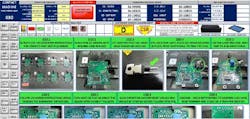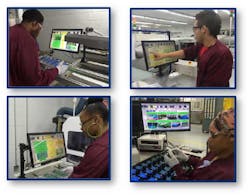When Firstronic CEO John Sammut left Colorado’s EPIC Technologies following the terrible loss of his young son to a brain tumor, he could not have known that his next electronics endeavor would prove to be so very difficult and so very rewarding. He moved on to Michigan-based Firstronic, into the heart of a de-industrializing United States, and there he would attempt to prove that the US could, with its own home-grown workforce, good suppliers, better customers, some manufacturing innovation, and a very focused work ethic, take back a piece of the US’ industrial landscape. By the time Firstronic was named a finalist for the PACE Award, followed by IndustryWeek ‘s Best Plants Award in May 2017, the picture was getting clearer and brighter. It was possible. Indeed Firstronic now ships over 25% of its product to the Far East!
Systems – Lean is an Assumption, IT a Necessity
We talked with Sandy Kolp, Firstronic’s director of Program Management and Grand Rapids’ plant manager, about how this incredible combination of people and systems had come together. It was not, we were told, without missteps.
With 50 customers worldwide, Firstronic had just picked up a major medical customer while automotive represents 65% of its business. Smooth and fast product launches are a requirement in the EMS sector, but it had become clear that the company needed better IT systems if they were going to connect 24/7 with suppliers. Plus under the old system, a simple off the shelf package that brought materials in and shipped product out, what happened in between in production was managed by a mish-mosh of systems. The company looked at four IT solutions – Oracle, SAP, Plex Systems and Infor - settling on Plex because they needed a cloud-based ERP system that would allow users to log in and connect from anywhere. “We wanted to eliminate outside databases,” said Kolp, “and we were hoping to go completely paperless.” The Plex system is browser, rather than local installation based.
Paperless Assembly
White boards and log books just wouldn’t cut it with Firstronic’s expected volumes. “We knew whatever system we went with had to be scalable,” Kolp added, because higher volumes with more product variety required at minimum a robust ERP system that would link production lines directly to suppliers. The company boasts a mixed technologies product base, with complexity growing. “It was a huge project to go to touch screen paperless. But paper in a manufacturing plant makes the floor look dirty,” she said, further explaining the move. “And we try not to use a lot of words – we want our assembly instructions, for example, to be very intuitive. We developed a simple Reaction Plan for operators, and that moved responsibility out to where it belonged – with the operators.”
“Roaming QA (Quality Assurance)”
Quality control in high volume electronics requires process accountability among employees. The company solved another quality challenge, however, when it removed downstream end-of-line inspectors, replacing them what Kolp calls “roaming Quality Control” by way of a GoGo cart.
As a result, the customer scorecard showed improved ppm from 170 at the initial launch of Roaming QA, to 7 six months later, and the rate continued to drop. “We had to find a way to hold people accountable to the quality process,” she said.
A traditional quality control process depends on the “catch mode” to spot and sideline errors. But Firstronic discovered that even 100% downstream product verification based on end-of- process flow was an expensive and inefficient way to run an electronics business. And it would not help grow a satisfied customer base.
The solution – real time, constant sampling of major process output - reflects a better use of technology; an average of 40 audits per 12-hour shift are conducted based on a sampling size determined by risk in terms of the product yield and historical failure rates. By tracking parts per million performance on the Customer Scorecard, Firstronic has been able to confirm the effectiveness of Roaming Quality Assurance.
A closed loop work-in-process control system
Plex offered a great next generation solution during this transition with Touch Screen Plex stations positioned at each work center. But rather than dumping last generation’s paper-based assembly instructions into the shiny new IT system, the company developed and launched for all part numbers a next generation touch screen-friendly assembly instruction format. The new production control app was bound to make sense out on the floor because it was developed based on direct labor input and requests.
To keep the new system in sync and up to date, the document control process was changed to directly link current revision assembly instructions to the appropriate production floor work centers through an operator controlled control panel. This approach provides consistent and easily retrievable information for each part number’s assembly instructions for every work center.
Real time updates and revisions can be launched remotely by document control and they are viewable immediately on the production floor by operators.
“Not everyone,” says Kolp, “is cut out for manufacturing or factory work!” But how to identify and hire the right ones? Again, innovation stepped in as the company implemented a simple screening process called AcuMax. Candidates were rated as red, yellow or green based on established profiles. Red meant a bad fit – these hires would not become long-term employees; yellow signaled concern, although the hire could potentially be a good candidate, and green was a go.
The company established a baseline by testing all current employees. Profiles for each hourly and salaried position defined the ideal candidate. Only yellows and greens were interviewed.
But when turnover rose to unacceptable levels, Firstronic was challenged to figure out what was going wrong. What they discovered – new hires were screened, hired, deployed and then, they thought, “forgotten” – led to a new mentoring and graduation process that cut turnover from 6% in June 2015, to 1.1% nine months later. As the turnover rate dropped quality rose, and it became clear that hiring and training the right employees needed to be supported by on-going mentoring and communications with new hires.
Results
Firstronic is proud of their innovative approach to business the U.S. had largely surrendered and offshored. With a three-year growth rate exceeding 250% the company can point to workforce, quality assurance, and IT solutions that challenge traditional methods. By combining user friendly IT with smart documentation management and the innovative GoGo cart, along with an energized workforce, Firstronic feels that the company has assured its own continued growth and success. Exports of less than $5 million in 2012 have grown to a 2017 forecast of $30 million.





